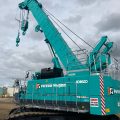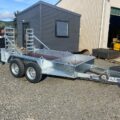Choosing the right crane for your project can be a daunting task. There are many factors to consider, such as the size and weight of your load, the type of terrain you’ll be working on, and your budget. But with a little research and advice from experts, you can find the perfect crane for your needs.
What are the different types of cranes?
All-terrain crane
An all-terrain crane is a type of crane that is designed to be used on a variety of terrain, including soft or uneven ground, gravel, and snow. All-terrain cranes are typically used for construction and heavy lifting applications.
All-terrain cranes are built on a special chassis that is designed for rough terrain. The chassis has a wide wheelbase and low centre of gravity to provide stability on uneven ground. The crane also has special tires that provide traction on soft or slippery surfaces.
All-terrain cranes typically have a boom length of 30 to 50 meters (100 to 165 feet). The boom can be extended to reach even higher heights if necessary. The crane also has a winch that can be used to lift heavy loads.
All-terrain cranes are operated by a certified crane operator. The operator controls the crane using a joystick that is located in the cab. The operator has a clear view of the crane’s boom and loads at all times.
All-terrain cranes are very versatile and can be used for a variety of applications. They are commonly used to lift and move heavy loads, such as construction materials, machinery, and vehicles. All-terrain cranes can also be used to move objects that are too large or too heavy to be moved by hand.
Crawler Crane
A crawler crane is a type of crane that uses an undercarriage with crawler tracks to move around. They are typically used for very heavy lifting, such as lifting pieces of machinery or large structures.
Crawler cranes are unique in that they can move both horizontally and vertically, and can rotate a full 360 degrees. This makes them very versatile and able to reach places that other types of cranes cannot. They are also very stable, which is important when lifting heavy objects.
Crawler cranes typically have a boom that can extend up to 200 feet (61 meters). The length of the boom is one of the main factors that determine the lifting capacity of the crane. The crane also has a counterweight that helps balance the load and prevent the crane from tipping over.
Crawler cranes are used for a variety of purposes, including lifting heavy machinery, lifting sections of buildings or bridges during construction, and lifting storage tanks or other large containers. They are also used for disaster relief, such as lifting collapsed buildings or rescuing people from high places.
If you need a crane that can reach high places and lift heavy loads, a crawler crane is a good option. They are versatile and stable and can be used in a variety of settings.
Tower Crane
A tower crane is one of the most commonly used pieces of construction equipment on large-scale construction sites. Its main purpose is to hoist materials and move them vertically or horizontally, as needed. Tower cranes are used to construct tall buildings, including skyscrapers. They are also used to construct bridges, power plants, and dams.
Tower cranes are operated by a certified operator who sits in a cab at the top of the crane. The operator has a clear view of the construction site and can control the crane’s movements with joysticks. The crane’s operator is also responsible for communicating with the ground crew to coordinate the delivery of materials.
The tower crane gets its name from its tall tower-like structure. The crane’s tower is made of steel or concrete and can be as tall as 200 feet. The tower is anchored to the ground with large bolts and guy wires. The guy wires help to stabilize the crane during high winds.
At the top of the tower is the crane’s cab where the operator sits. The cab is outfitted with large windows and joysticks that control the crane’s movements. The crane’s operator also has a radio to communicate with the ground crew.
The crane’s boom is the long arm that extends out from the tower. The boom is used to hoist materials and move them horizontally. The boom is made of steel and can be up to 300 feet long.
At the end of the boom is the crane’s hook. The hook is used to attach to materials that need to be lifted. The hook is lowered down to the ground where the ground crew attaches the material. The ground crew uses a signal to let the operator know when the material is secure and ready to be lifted.
Once the material is secure, the operator uses the crane’s joysticks to lift the material off the ground and move it to the desired location. The operator can also rotate the boom to move the material horizontally.
Tower cranes are an essential piece of equipment on any large construction site. They are used to lift heavy materials and move them into place. Tower cranes are operated by a certified crane operator who sits in a cab at the top of the crane. The operator uses joysticks to control the crane’s movements.
Spider Crane
A spider crane is a special type of crane that is used to move heavy objects in tight spaces. It is named for its resemblance to a spider, with its long, slender body and many legs.
Spider cranes are very versatile and can be used in a variety of settings, including construction sites, warehouses, and even shipyards. They are often used to move heavy machinery or to lift large pieces of equipment.
Spider cranes are available in a variety of sizes, depending on the weight of the objects they will be lifting.
Spider cranes are operated by a certified operator who is trained in the use of the crane. The operator uses a remote control to operate the crane’s movements.
Gantry Cranes
A gantry crane is a type of crane that is supported by an A-frame and can move along a set of rails or tracks. Gantry cranes are commonly used in shipyards and ports to load and unload heavy cargo. They can also be used in construction and manufacturing to move materials around a worksite.
Gantry cranes typically have a lifting capacity of up to several hundred tons, making them much larger and more powerful than the more common overhead crane. They also tend to be much more expensive, so they are not always the best option for every application.
When choosing a gantry crane, it is important to consider the specific needs of the job at hand. The crane’s lifting capacity, span, and height all need to be taken into account. It is also important to make sure that the crane will be able to fit into the available space and that it can be properly supported.
Gantry cranes can be powered by electricity, diesel, or natural gas. Electric cranes are typically the most expensive but also the most versatile. Diesel and natural gas cranes are less expensive but may not be able to operate in all areas.
Gantry cranes are an essential piece of equipment in many industries. They are safe, efficient, and reliable. With the proper care and maintenance, they can last for many years.
What factors should you consider when choosing a crane for your project?
When it comes to choosing a crane for your project, there are a few key factors you need to take into consideration. Here are a few of the most important ones:
The weight of the load you need to lift:
This is perhaps the most important factor to consider when choosing a crane. Make sure you know the exact weight of the load you need to lift, as this will dictate the size and type of crane you need.
The height and distance you need to lift the load:
Again, this will have an impact on the size and type of crane you need. If you need to lift a heavy load a long distance, you’ll need a larger and more powerful crane.
The type of terrain you’ll be working on:
This is important for two reasons. Firstly, it will dictate the type of crane you need (e.g. an all-terrain crane for rough terrain). Secondly, it will impact the stability of the crane, so make sure you choose a crane that’s suitable for the terrain you’ll be working on.
The weather conditions you’ll be working in:
Bad weather can make operating a crane very difficult and dangerous. If you know you’ll be working in adverse conditions, make sure you choose a crane that’s designed for those conditions.
Your budget
Cranes can be expensive, so it’s important to consider your budget when choosing one. There are a number of ways to save money on a crane, so don’t be afraid to shop around and compare prices.
By considering all of these factors, you can be sure to choose the right crane for your project.











